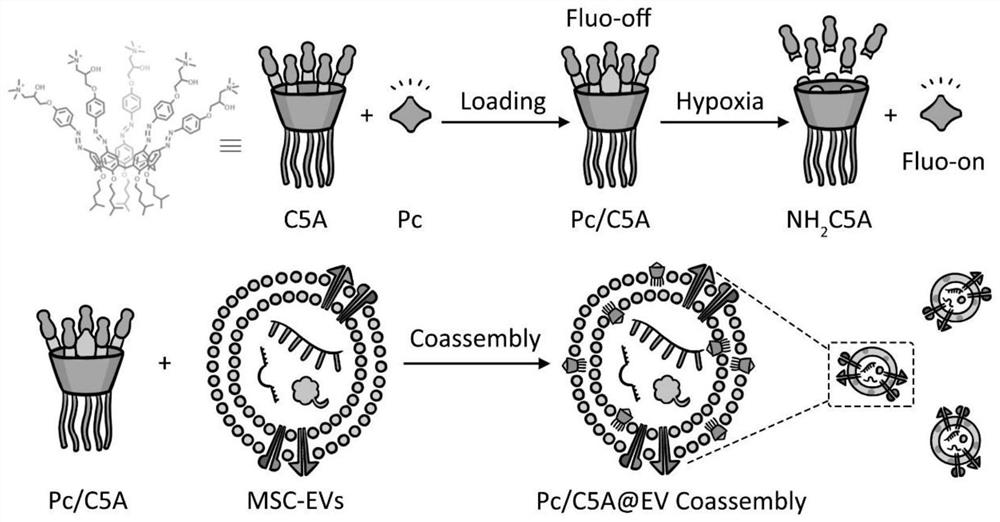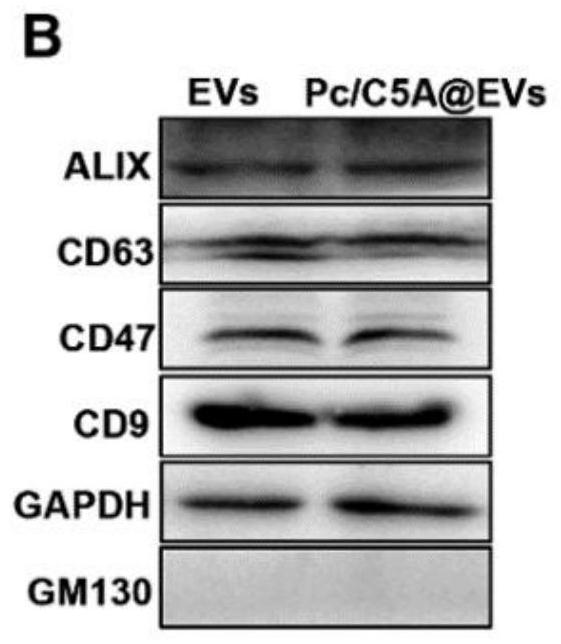A hypoxia-responsive co-assembly system based on extracellular vesicles and preparation method thereof
A co-assembly and system technology, applied in the biological field, can solve problems such as special equipment complexity space, body death, body damage, etc.
- Summary
- Abstract
- Description
- Claims
- Application Information
AI Technical Summary
Problems solved by technology
Method used
Image
Examples
Embodiment 1
[0075] This example is used to illustrate a method for extracting extracellular vesicles derived from umbilical cord-derived mesenchymal stem cells.
[0076] The processing steps are as follows: place fetal bovine serum in an ultracentrifuge tube, centrifuge at 100,000g at 4°C for 2 hours, take the supernatant in an ultra-clean bench, filter with a 0.22 μm needle filter, and store it in a -80°C refrigerator for later use.
[0077] For cell biology experiments such as cell subculture, cryopreservation and recovery, please refer to "Animal Cell Culture (Sixth Edition)".
[0078] Conditioned medium for collecting human umbilical cord-derived mesenchymal stem cells (hP-MSCs) containing extracellular vesicles: when cultured at 75 cm 2 The hP-MSCs in the cell culture flask were in the logarithmic growth phase, and when the cell confluence reached 80%, the medium was exhausted, washed twice with PBS, and 10 ml of prepared 10% extracellular vesicle-free solution was added to each flas...
Embodiment 2
[0085] This example is used to illustrate a method for preparing a co-assembly system based on extracellular vesicles (EVs) for hypoxia-responsive imaging.
[0086] (1) After mixing aluminum phthalocyanine Pc and calixarene C5A respectively, they were treated in a dark room at 37°C for 30 min.
[0087] (2) Add Pc / C5A to the extracted 100 μL EVs sample containing 200-300 μg protein, make up to 500 μL with PBS, at this time the final concentration of Pc / C5A is 10 μM / 20 μM, invert and mix, and warm at 37°C Incubate for 2h.
[0088] (3) The above mixture was transferred into an ultracentrifuge tube, filled with PBS, centrifuged at 100,000 g at 4° C. for 120 minutes, and the supernatant was removed to obtain green-stained extracellular vesicles.
[0089] (4) Resuspend the extracellular vesicles in 50 μl PBS, aliquot and store in a -80°C refrigerator for later use.
Embodiment 3
[0091] This example is used to illustrate a method for the identification of a hypoxia-responsive imaging co-assembly system based on extracellular vesicles (EVs).
[0092] (1) Identification of extracellular vesicle morphology using transmission electron microscopy
[0093] The extracellular vesicles extracted in Example 1 and the hypoxia response imaging co-assembly system of Example 2 were dropped on a 200-mesh sample copper grid, kept at room temperature for 2 min, and the excess liquid was blotted with filter paper; 20 mg / mL was added dropwise on the sample grid. The uranyl acetate solution was allowed to stand at room temperature for 1 min, the samples were negatively stained, the excess liquid was blotted with filter paper, and the sample net was air-dried; the prepared samples were observed under a transmission electron microscope, and photographs were collected. like figure 1 As shown, the shape and diameter of extracellular vesicles did not change, and the shape was...
PUM
 Login to View More
Login to View More Abstract
Description
Claims
Application Information
 Login to View More
Login to View More - R&D
- Intellectual Property
- Life Sciences
- Materials
- Tech Scout
- Unparalleled Data Quality
- Higher Quality Content
- 60% Fewer Hallucinations
Browse by: Latest US Patents, China's latest patents, Technical Efficacy Thesaurus, Application Domain, Technology Topic, Popular Technical Reports.
© 2025 PatSnap. All rights reserved.Legal|Privacy policy|Modern Slavery Act Transparency Statement|Sitemap|About US| Contact US: help@patsnap.com



